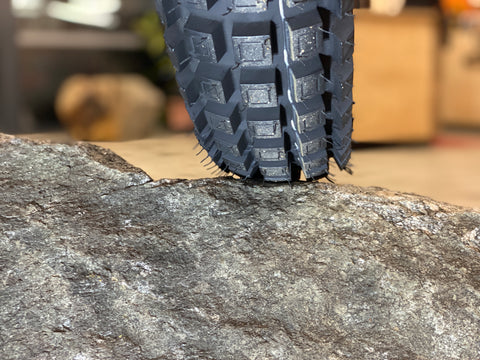Tyre Pressure for Trials Riding
Without traction you’ve got nothing!
If you are riding Trials, the connection between your Michelin X-lite or X-11, and the ground matters! Setting the right pressure becomes an important step. Generally speaking most Trials riders will want between 4psi - 5psi in the back tyre, and 6psi - 6.5psi in the front. But this is a generalisation.
As Trials riders we don’t run mousse’s, and we are riding such a wide range of terrain that we often need to make adjustments to suit the situation.
What happens when the pressure is too high?
When tyre pressure is too high, the tyre becomes more rounded. This reduces the “footprint” or the amount of rubber actually touching the ground. The less rubber that touches the ground the less surface area and friction (AKA Traction) you have.
You will notice that when your front tyre is pumped up too high, the front wheel is very easy to turn on the spot. That is because there is less rubber on the ground (smaller footprint), and in turn there is less traction.

A smaller footprint has 3 effects that make it harder to static balance.
- The base you are balancing on, (which is the tyres footprint on the ground) is much smaller or narrower.
- When you turn the handlebars, it won't push the bike left or right as much, as there is slightly less offset of the contact patch, to steering axis.
- Because the handle bars will turn easily, you won't get the feedback or feeling from the front wheel and it will be harder for you to “feel” how much turn you need to correct your balance.
A tyre that is over inflated, will have less traction, tend to push on turns (ie slide in a straight line and not turn). If really over inflated, it can cause you more impact when you hit bumps.
The one big positive from the pressure being too high, is you are far less likely to get a pinch flat from hitting something too hard.
What happens when the pressure is too low?
When the tyre pressure is too low, the tyre gets flatter, the Trials type tread pattern which is all squares, will come together and join up, causing the tyre to become a “slick” tyre. The mud or dirt can't get between the knobs and the tyre will tend to “float” on this surface.

When the pressure in your Trials tyre is too low, this will also cause instability as the rim will move back and forth, sideways over the tread pattern on the ground. So the front wheel will not feel planted and solid. The rear wheel will feel the same and will tend to cause you to fall inwards on turns.
Also the tyre will tend to get hotter from the excess friction from rolling over itself. This will shorten the life of the tyre in general. Especially in the Michelin X-lite. They have a lighter weight sidewall, which is more likely to break down over time. Both the Michelin X11 and Dunlop tend to have a heavier sidewall and tend to be more durable, but heavier.
When the tyre pressure is too low you will also be far more susceptible to pinch flats.
So what is the best pressure to run
There is no such thing as the “perfect pressure” this will vary depending on a few things;
- The weight of the rider and bike,
- The traction and conditions,
- Risk of punctures.
Ok i just want a single figure…
Generally speaking, if you are around an average weight of 70-90kgs then pressures of 4.5psi in the rear, and 6.5 psi in the front, are going to be fine in pretty well all conditions.
Making adjustments
If your weight is higher than that, you can go up to around 5psi at the rear and 7psi on the front.
If things get a little more greasy and slippery, you may want to drop the pressure a little more. I would suggest that most riders would have 4psi as the lowest they go on the rear tyre. I am 68kgs and I find my lower limit is 3.8psi. Any lower and I lose traction.
|
Rider Weight |
Under 70kg (154lbs) |
70-90kg (154-198lbs) |
Over 90kg (198lbs) |
|
Front |
6psi / 0.41bar |
6.5psi / 0.44bar |
7psi / 0.48bar |
|
Rear |
4psi / 0.27bar |
4.5psi / 0.31bar |
5psi / 0.34bar |
|
A guide to rear tyre minimum for slippery conditions |
3.5psi / 0.20bar |
3.8psi / 0.26bar |
4psi / 0.27bar |
|
All figures here are only a guide. Use these as a starting point then experiment from there. |
|||
If you are really light weight and your bike is light, i.e. a young rider on a big wheel 80cc for example, you need to experiment to find the right pressure to get the best tyre footprint. I actually know of a few parents who had to take the valve out, for their kids to get a decent footprint.
Small changes have a big effect in Trials.
Play and experiment and you will notice the little differences. You will develop a feel for what is the best pressure for you. You will notice that even 0.5psi can make a significant difference in a particular spot. So make sure you get yourself a good accurate low pressure gauge. You want one that is 0-15psi. If possible with a bleed valve.
Get yourself a good accurate 0-15psi gauge with bleed button here
Gauges are not accurate at the bottom or top of their range. They are more accurate in the middle of their range.
At elite level trials they check tyre pressure EVERY section.
For the normal club rider, that's a little over the top. Instead make sure that you set your pressures after you have warmed up in the morning, and check it again later in the day if you are coming past the pit. The reason being, as the tyre warms, the pressure will rise. You can very easily gain 1psi in 10 mins of riding.
Conversely if you ride through cold water the pressure will drop.
If you are riding at altitude, pressure will rise the higher you go, and drop the lower you go.
What to do from here!
- Get yourself a good pressure gauge (0-15psi with bleed valve, i like the hose variety) - Tyre Preasure Gauge
- Roughly weigh yourself.
- Use the Table as guide to find your starting point.
- Set the final pressure after you have warmed up the tyres.
- Check them after a lap in an event if you are able to.
- Find EPIC traction and ride like a champion!

